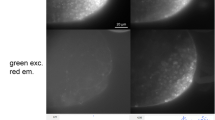Abstract
The essential steps of the 33258 Hoechst-Giemsa method for differential chromatid staining consist of (1) 33258 Hoechst treatment, (2) exposure to light, and (3) Giemsa staining. The staining was shown to be a function of the concentration of 33258 Hoechst and the light exposure. The dye was successfully replaced by various metachromatic dyes such as thionine. Two simple methods are proposed. Failure of the pale stained chromatids to restore Giemsa affinity with urea and trypsin and the diminished Feulgen reaction after light exposure suggest that not masking proteins but photolysis of the BrdU-incorporated chromatid components in the presence of photosensitive dyes play a role in the differential staining.
Similar content being viewed by others
References
Arrighi, E., Hsu, T. C.: Localization of heterochromatin in human chromosomes. Cytogenetics 10, 81–86 (1971)
Bianchi, N. O.: Chromosomes of the rat. II. DNA replication sequence of bone marrow chromosomes in vivo. Cytologia (Tokyo) 31, 276–293 (1966)
Bowen, E. J., Wokes, F.: Fluorescence of solutions. London: Longmans 1953
Huang, C. C.: Induction of a high incidence of damage to the X chromosomes of Rattus (Mastomys) natalensis by base analogues, viruses, and carcinogens. Chromosoma (Berl.) 23, 162–179 (1967)
Ikushima, T., Wolff, S.: Sister chromatid exchanges induced by light flashes to 5-bromodeoxyuridine- and 5-iododeoxyuridine substituted Chinese hamster chromosomes. Exp. Cell Res. 87, 15–19 (1974)
Kato, H.: Spontaneous sister chromatid exchanges detected by a BUdR-labelling method. Nature (Lond.) 251, 70–72 (1974a)
Kato, H.: Is isolabeling a false image ? Exp. Cell Res. 89, 416–420 (1974)
Kim, A.: Chromatidaustausch und Heterochromatinveränderungen menschlicher Chromosomen nach BUdR-Markierung. Hum. Genet. 25, 179–188 (1974)
Korenberg, J. R., Freedlender, E. F.: Giemsa technique for the detection of sister chromatid exchanges. Chromosoma (Berl.) 48, 355–360 (1974)
Latt, S. A.: Microfluorometric detection of deoxyribonucleic acid replication in human metaphase chromosomes. Proc. nat. Acad. Sci. (Wash.) 70, 3395–3399 (1973)
Latt, S. A.: Sister chromatid exchanges, indices of human chromosome damage and repair: detection by fluorescence and induction by Mitomycin C. Proc. nat. Acad. Sci. (Wash.) 71, 3162–3166 (1974)
Perry, P., Wolff, S.: New Giemsa method for the differential staining of sister chromatids. Nature (Lond.) 251, 156–158 (1974)
Regan, J. D., Setlow, R. B., Ley, R. D.: Normal and defective repair of damaged DNA in human cells: a sensitive assay utilizing the photolysis of bromodeoxyuridine. Proc. nat. Acad. Sci. (Wash.) 68, 708–712 (1971)
Seabright, M.: A rapid banding technique for human chromosomes. Lancet 1971 II, 971–972
Shibatani, A., Naora, H.: Feulgen reaction and quantitative cytochemistry of desoxypentose nucleic acid. IV. Microspectrophotometric study of the Feulgen reaction in situ. Biochim. biophys. Acta (Amst.) 12, 515–521 (1953)
Shiraishi, Y., Yosida, T. H.: Banding pattern analysis of human chromosomes by use of a urea treatment technique. Chromosoma (Berl.) 37, 75–83 (1972)
Sugiyama, T.: The mechanism of specific staining of acid mucopolysaccharide by alcian blue: on the influence of urea treatment on the stainability. Acta Histochem. Cytochem. 1, 16–30 (1968)
Sugiyama, T.: Specific vulnerability of the largest telocentric chromosome of rat bone marrow cells to 7,12-dimethylbenz(a)-anthracene. J. nat. Cancer Inst. 47, 1267–1275 (1971)
Sugiyama, T.: Chromatid rearrangement and carcinogenesis. Gann Monogr. Cancer Res. (Tokyo) 17, 393–403 (1975)
Sumner, A. T., Evans, H. J., Buckland, R. A.: New technique for distinguishing between human chromosomes. Nature (Lond.) New Biol. 232, 31–32 (1971)
Wolff, S., Perry, P.: Differential Giemsa staining of sister chromatids and the study of sister chromatid exchanges without autoradiography. Chromosoma (Berl.) 48, 341–353 (1974)
Zakharov, A. F., Egolina, N. A.: Differential spiralization along mammalian mitotic chromosomes. I. BUdR-reversed differentiation in Chinese hamster chromosomes. Chromosoma (Berl.) 38, 341–365 (1972)
Author information
Authors and Affiliations
Rights and permissions
About this article
Cite this article
Goto, K., Akematsu, T., Shimazu, H. et al. Simple differential Giemsa staining of sister chromatids after treatment with photosensitive dyes and exposure to light and the mechanism of staining. Chromosoma 53, 223–230 (1975). https://doi.org/10.1007/BF00329173
Received:
Accepted:
Issue Date:
DOI: https://doi.org/10.1007/BF00329173




